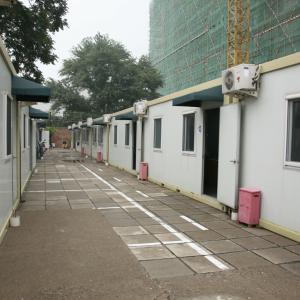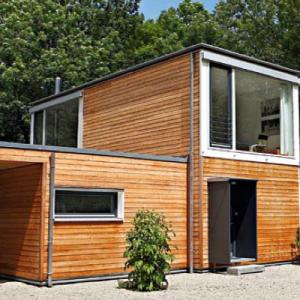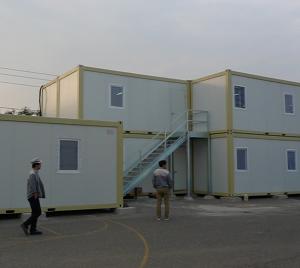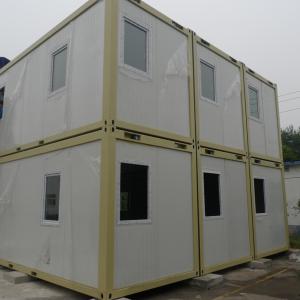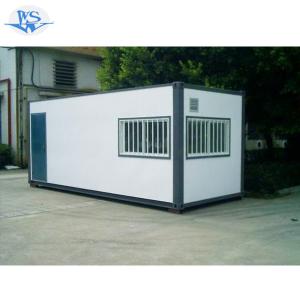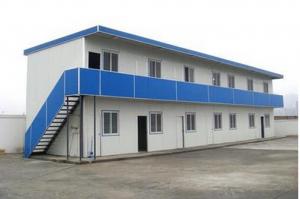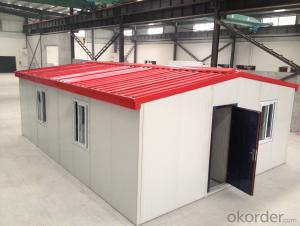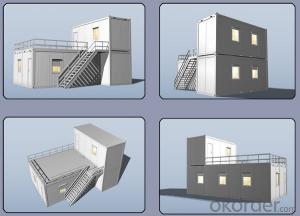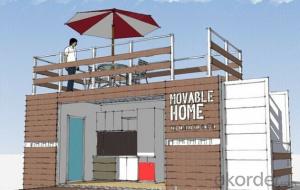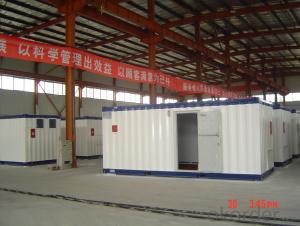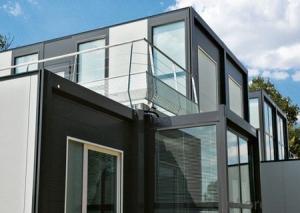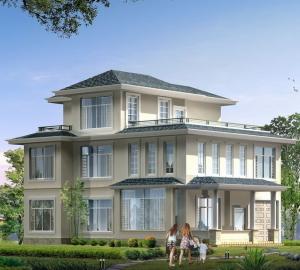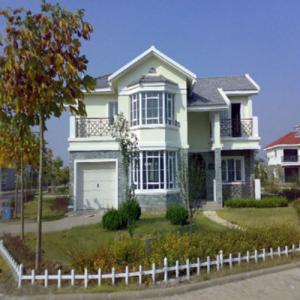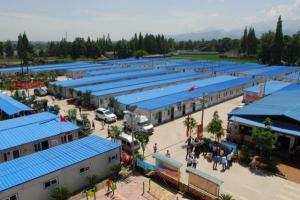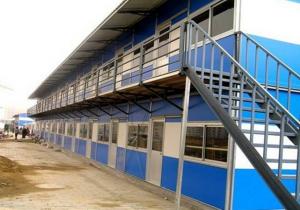20FT sandwich panel container house for living homes
- Loading Port:
- Tianjin
- Payment Terms:
- TT OR LC
- Min Order Qty:
- -
- Supply Capability:
- 500 Sets set/month
OKorder Service Pledge
OKorder Financial Service
You Might Also Like
20FT sandwich panel container house for living homes
This is our basic product called Flat-packed container house. It is widely used foroffice, accommodation and commercial kiosk.
ProductFeatures:

Dimension(mm)&Weight(kg)
Type | External | Internal | Weight (kg) | |||||
Length | Width | Height (package) | Height (assembled) | Length | Width | Height | ||
20’ | 6055 | 2435 | 648/864 | 2591/2790 | 5860 | 2240 | 2500 | from 1850 |
Floor
Steel frame | - made from cold rolled, welded steel profiles, 4 mm thick |
- 4 corner casts, welded | |
- 2 fork lift pockets (except 30’) - distance 1200mm (internal clearance of fork lift pockets: 240×80 mm) | |
- steel cross members, thickness=2mm | |
Insulation | - 100 mm thick Rock Wool |
Subfloor | - 0.5mm thick, galvanized steel sheet |
Floor | - 18mm plywood board |
- 1.8mm PVC floor - flammability class B1 - hardly combustible - smoke density class Q1 - low smoke emission - wear resistance factor: T level |
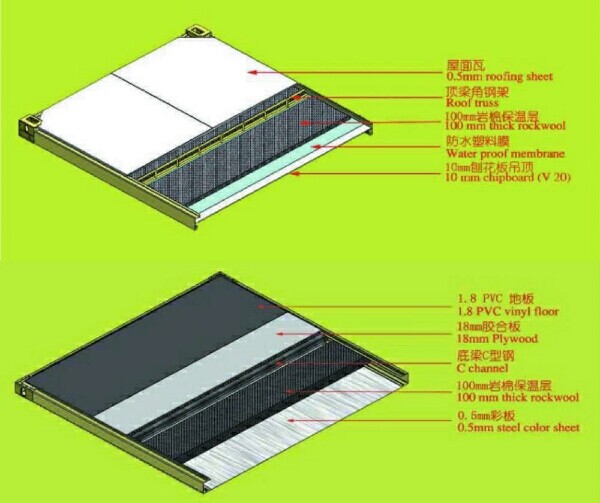
Insulation
Rockwool | - density:120kg/m3 |
- flammability class A- non combustible - smoke density class Q1 - low smoke emissio n | |
- certificated: CE & GL | |
NeoporR | - density:18kg/m3 |
- flammability class B1- non combustible - smoke density class Q1 - low smoke emission | |
- certificated: CE & GL |
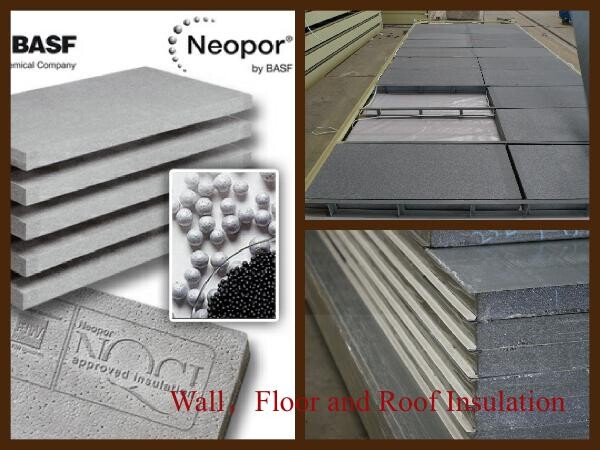

Coatings(Optional)
Deco Coating | Special coating can be applied on top of sandwich wall panel and make the external wall surface looks like plastering finishes or timber finishes. That makes the container house cozy and less industry look. |

Packaging & Shipping
From ourfactory to overseas client, there are two ways to delivery the houses. If yourport can accept SOC (Shipper’s Owned Container), 4 standard cabins can bepacked as a 20ftcontainer and shipped naked. If can not, 7standard cabins can be loaded into one40ft HC.
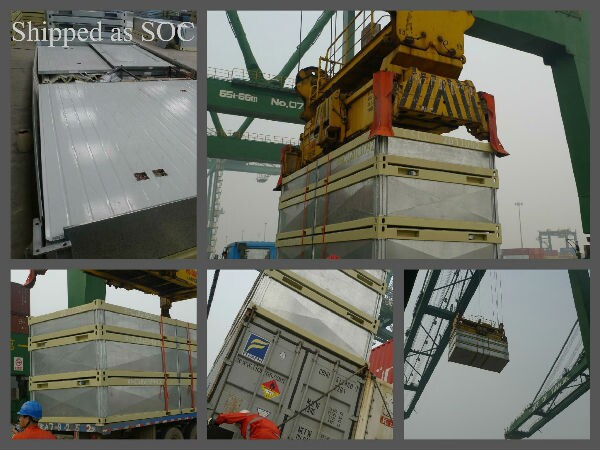

From thedealer’s workshop to the client’s place, it can be delivered by 6m long truck after assembly. The width and height are within traffic limitation.

Our Services
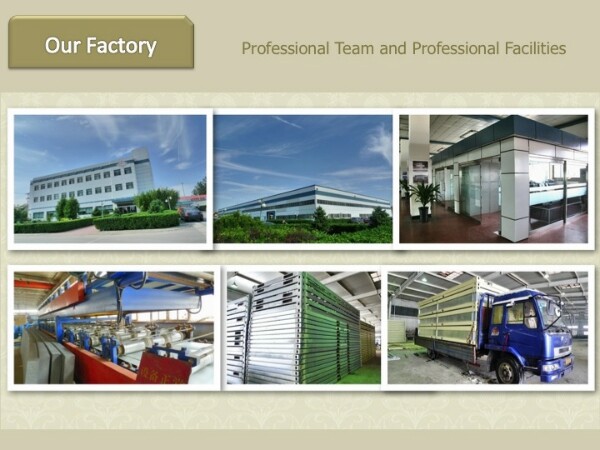
Wecould provide deisgn, manufacture, logistic and on-site instruction services.
Company Information



- Q: Are container houses suitable for areas with limited access to schools?
- Yes, container houses can be suitable for areas with limited access to schools. Container houses can be designed and set up in various locations, including remote areas where traditional housing options may not be feasible. These houses can provide a cost-effective and quick solution to accommodate families in areas with limited access to schools. Additionally, container houses can be customized and equipped with the necessary facilities to support educational needs, such as study areas and internet connectivity, making them a viable option for areas with limited school access.
- Q: Can container houses be designed with a wine cellar?
- Absolutely! Wine cellars can definitely be included in the design of container houses. Container houses are renowned for their versatility and adaptability, which opens up a world of creative and distinctive design options. By carefully planning and making structural adjustments, it is entirely possible to incorporate a wine cellar into the layout of a container house. The interior of the container can be properly insulated, equipped with climate control systems, and furnished with suitable shelving and storage units to create an ideal environment for storing and aging wine. Moreover, the compact nature of container houses allows for efficient use of space, enabling the creation of a functional and visually appealing wine cellar within the limited area of a container. Whether it is intended for personal enjoyment or as an exceptional feature to impress guests, a wine cellar can certainly be designed and seamlessly integrated into a container house.
- Q: Are container houses earthquake-resistant?
- Yes, container houses can be earthquake-resistant when properly designed and constructed. The use of strong steel frames and reinforced foundation systems can enhance their structural integrity, making them more resilient to seismic activity. Additionally, the compact and modular nature of container houses allows for easier implementation of earthquake-resistant features, such as flexible connections and effective bracing systems. However, it is essential to ensure that the design and construction of container houses adhere to local building codes and standards to maximize their earthquake resistance.
- Q: Can container houses be designed for communal living?
- Yes, container houses can certainly be designed for communal living. Container houses have emerged as a popular alternative to traditional housing due to their affordability, sustainability, and flexibility. Their modular design allows for easy customization and adaptation to various living arrangements, including communal living. Container houses can be designed to accommodate multiple individuals or families by connecting multiple containers together or stacking them vertically. This allows for the creation of shared spaces such as communal kitchens, dining areas, living rooms, and recreational facilities. By utilizing open floor plans and maximizing the use of natural light, container houses can be transformed into spacious and inviting communal living environments. Furthermore, container houses can be equipped with all the necessary amenities and facilities required for communal living. These can include shared bathrooms, laundry rooms, storage spaces, and outdoor communal areas. With proper insulation, climate control, and soundproofing measures, container houses can provide a comfortable and functional communal living experience. Additionally, container houses can be designed with sustainability in mind, incorporating eco-friendly features such as rainwater harvesting systems, solar panels, and energy-efficient appliances. This further enhances the appeal of container houses for communal living, as it promotes a sustainable and eco-conscious lifestyle. In conclusion, container houses are versatile and can be effectively designed for communal living. Their modular nature, affordability, and sustainability make them an attractive option for individuals or groups seeking an alternative housing solution that promotes shared living experiences.
- Q: Are container houses suitable for recreational or vacation rentals?
- Yes, container houses can be suitable for recreational or vacation rentals. They are versatile, cost-effective, and can be easily customized to provide comfortable accommodations. Container houses can offer a unique and eco-friendly experience for vacationers, and their portable nature allows for flexibility in location. Additionally, their sturdy construction and durability make them suitable for withstanding various weather conditions, ensuring a safe and enjoyable stay for guests.
- Q: Are container houses prone to condensation or humidity issues?
- Container houses can be prone to condensation or humidity issues if not properly insulated and ventilated. The metal walls of shipping containers have a high thermal conductivity, which means they can easily transfer heat and moisture. Without proper insulation, the temperature inside the container can fluctuate drastically, leading to condensation when warm air meets colder surfaces. This can result in moisture buildup, leading to mold, mildew, and potential damage to the structure. However, with proper insulation and ventilation, container houses can effectively manage condensation and humidity. Adding insulation materials such as spray foam, rigid foam boards, or mineral wool can help regulate the internal temperature and prevent moisture buildup. Additionally, installing proper ventilation systems like vents, fans, or dehumidifiers can help control humidity levels within the container. It's important to note that the location and climate also play a significant role in determining the likelihood of condensation or humidity issues. In regions with high humidity, such as coastal areas, extra precautions should be taken to ensure sufficient insulation and ventilation to prevent moisture problems. In summary, while container houses can be prone to condensation or humidity issues, proper insulation and ventilation can effectively mitigate these problems. It's crucial to invest in quality insulation materials and design a well-ventilated system to maintain a comfortable and moisture-free living environment inside the container house.
- Q: What are the common floor plans for container houses?
- There are several common floor plans for container houses that can be customized to meet different needs and preferences. One of the most popular floor plans is the single-container layout, where a single shipping container is used as the main living space. This layout typically includes an open living area, a kitchenette, a bathroom, and a sleeping area. Another common floor plan is the multi-container layout, where multiple containers are combined to create a larger living space. This layout allows for more flexibility in terms of design and can include multiple bedrooms, a full-sized kitchen, a spacious living area, and additional rooms such as a home office or a storage area. Additionally, there are also two-story container house floor plans, where containers are stacked vertically to maximize space. This layout can include multiple bedrooms, bathrooms, and living areas on different levels, providing a more traditional home feel. Some container house floor plans also incorporate outdoor living spaces, such as covered decks or rooftop gardens, to make the most of the available space and create a seamless indoor-outdoor living experience. Ultimately, the floor plans for container houses can vary greatly depending on individual preferences, budget, and the number of containers used. With the flexibility of container construction, the possibilities for designing a unique and functional home are virtually endless.
- Q: What is the difference between a container house and an activity board?
- the vertical direction can be stacked up to three layers. Box body structure is the use of special steel welded from the standard components, boxes and boxes connected by bolts, simple structure, easy installation
- Q: Are container houses cost-effective?
- Yes, container houses can be cost-effective for several reasons. Firstly, the materials used to build container houses are often cheaper compared to traditional construction materials such as bricks and cement. This can result in significant cost savings during the construction process. Additionally, container houses can be built relatively quickly, which further reduces labor costs. Furthermore, container houses are known for their energy efficiency. The compact design and the use of insulated materials make them easier to heat or cool, resulting in lower energy bills. Additionally, container houses can be equipped with solar panels or other renewable energy sources, further reducing energy costs. Moreover, container houses are highly durable and require minimal maintenance. The steel structure of shipping containers makes them resistant to harsh weather conditions and natural disasters, reducing the need for costly repairs or replacements in the long run. Finally, container houses offer great versatility. They can be easily modified or expanded, allowing homeowners to customize and adapt their living space as their needs change over time. This flexibility can save money compared to buying or building a new house to accommodate changing circumstances. Overall, while the cost-effectiveness of container houses depends on various factors such as location and customization, they generally offer lower construction and maintenance costs, energy efficiency, and flexibility, making them a cost-effective housing option for many individuals and families.
- Q: Are container houses hurricane-resistant?
- Container houses have the potential to be hurricane-resistant when they are designed and built appropriately to endure extreme weather conditions. Housing containers are typically constructed using sturdy steel and possess a robust structure capable of withstanding strong winds and heavy rainfall. It is important to consider, however, that the level of hurricane resistance may vary depending on factors such as construction quality, foundation type, and house design. Enhancing the hurricane resistance of container houses can be achieved through various reinforcements, such as incorporating additional steel supports or employing reinforced concrete foundations. Furthermore, implementing protective measures like hurricane shutters or impact-resistant windows can offer additional defense against flying debris during hurricanes. Overall, by employing proper construction techniques and taking necessary precautions, container houses can withstand hurricane-force winds and provide a secure living environment in areas prone to hurricanes.
Send your message to us
20FT sandwich panel container house for living homes
- Loading Port:
- Tianjin
- Payment Terms:
- TT OR LC
- Min Order Qty:
- -
- Supply Capability:
- 500 Sets set/month
OKorder Service Pledge
OKorder Financial Service
Similar products
Hot products
Hot Searches
Related keywords
